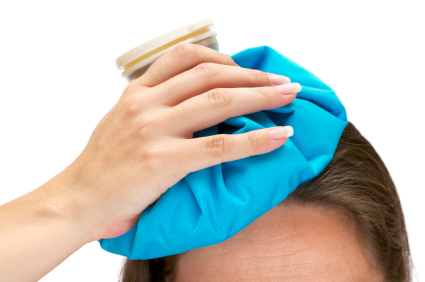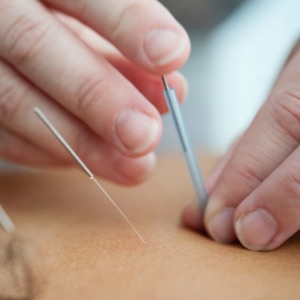Rethinking R.I.C.E.

By Jennifer Kapraun, LAc
“There can be inflammation without healing, but there can be no healing without inflammation.”
R.I.C.E. - Rest, Ice, Compression, and Elevation signifies, by almost universal agreement, the proper steps for treating an injury. As a practitioner of Traditional Chinese Medicine, I disagree. My colleagues and I seldom if ever recommend therapeutic use of ice. Until recently, I didn’t have an explanation for my patients on why I felt they should stop using ice for injuries and chronic pain. At least, not an explanation in plain English. I would say something like “Cold injures the yang qi”. Or “using ice is contrary to the treatment principles of Chinese Medicine.” Those patients who had been using ice for a very long time would, understandably, give me a blank look and say “but ice stops the inflammation, it’s been proven”. I couldn't object, as most research does show that applying ice slows the inflammatory process.
A little discouraged, I was learning not to press the issue of ice, even though I still suspected that icing couldn’t be good for long-term health and healing. Then, a few weeks ago, I stumbled across a Youtube video in which a group of sports enthusiasts talk with a prominent orthopedist for some major NFL teams about the widespread use of ice in sports medicine. What I learned is that some experts are now saying that the use of ice for injuries and pain is also an incorrect biomedical approach. Here’s why:
The problem with using ice is not that it doesn’t stop inflammation. The problem with using ice is precisely that it does stop the inflammation. Why should we want to stop inflammation? Is the body’s natural inflammatory response really a mistake to be corrected? Of course inflammation can be harmful, even deadly. For example, the inflammation that occurs inside the arteries of people with heart disease is a process that must be halted or slowed through lifestyle changes or with medication to prevent serious problems.
But the inflammation that occurs after an injury is not a mistake. On the contrary, it is the first necessary step in the healing process. The most basic description of the sequence of events that occur after injury to a muscle or ligament is:
Inflammation - redness, heat, swelling, pain
Repair - damaged tissue and waste molecules removed, scar tissue forms
Remodeling - new blood vessels grow, scar tissue replaced by normal tissue
It follows that stopping the inflammation by using ice or NSAIDs (Ibuprofen, etc.) effectively impairs healing. So why, you must be asking, does my doctor/physical therapist/chiropractor, etc. want me to use ice to reduce inflammation? The reason is probably this: inflammation can be a big problem if it goes on too long. Tissue damage can occur, chronic pain, and wounds that don’t heal.
Physicians who use ice believe that suppressing inflammation will prevent the negative effects of excessive inflammation. This may be true, but their mistake lies in ignoring the importance of a robust inflammatory response for robust healing. There is a better approach.
A better approach is to focus on what Mr. Starett in his video calls “taking out the garbage” and “bringing in the groceries.” And here is where we discover why using ice is harmful to healing and tissue re-growth. After an injury occurs, there is a complex cascade of cellular and molecular signaling that enable the clearing out of damaged tissue (the garbage) and the construction of new blood vessels to bring in nutrients (the groceries) to repair and rebuild new tissue .
Icing impedes the “garbage and groceries” exchange on three levels. First, ice numbs the nerves in the area and cuts off some of the key nerve signaling in the healing process. Second, ice tends to immobilize the muscles in the surrounding tissue, slowing the removal of waste via lymph vessels. Third, ice reduces bruising at the site, which negatively effects the formation of new blood vessels.
You may recall from basic biology or anatomy that the body has two circulatory systems: cardiovascular (heart and blood vessels) and lymphatic. While the heart and blood vessels contract to circulate the blood, the lymph vessels are completely passive. Fluid moves through them only by surrounding muscle movement and by gravity. Because the post-injury “garbage” molecules are too large to absorb back into the blood vessels, the only way they can exit the area is through the lymph vessels. This waste material can prolong the inflammation stage if it hangs around the injury site too long.
The reduced bruising achieved by icing after an injury is the most clearly visible way that ice is “effective”. But for complete healing, we don’t want to stop the bruising. Physiologists now have a better understanding of the chemical processes that occur in wound healing, and they now know that the blood breaking out of the blood vessels around the injury is what signals the body to grow new blood vessels in the area. If tissue is damaged but bleeding stopped and nerve signals blocked with ice, the body doesn't get the message that new blood vessels are needed, and the tissue heals, but is poorly nourished and therefore weak.***
This is why the R.I.C.E. acronym is wrong. The first two steps, rest and ice impair the body’s ability to complete the 1st, 2nd, and 3rd stages of healing. Compression and elevation alone are enough to keep fluid swelling and local bleeding in check without impeding the strong inflammatory response that sets off the repair and reconstruction phase.
I propose adding two additional steps when treating injuries:
M - Movement (4)
A - Acu-related therapies (acupuncture, moxibustion, herbs, etc.) (3)
C - Compression (1)
E - Elevation (2)
Granted, the order is wrong, and the acronym probably wouldn’t catch on for obvious reasons, but I do hope that in the coming years more physicians will realize that using ice and other anti-inflammatories is an incorrect treatment approach. Compressing and injured area with a bandage or athletic tape and Elevating the limb above the heart reduces pain and prevents excess fluid swelling and bleeding. Movement of surrounding muscles helps clear waste from the site.* Acupuncture, moxibustion, herbal soaks, plasters, liniments and compresses all help to increase circulation and relieve pain while promoting healing. These treatments can begin immediately following injury.**
It’s time to rethink R.I.C.E.
*If the limb cannot be safely or comfortably moved because of broken bones, ligament or tendon tears then massage or TENS stimulation above and below the affected area can help promote circulation.
**Consult a trained and licensed professional if you have questions about whether any of these treatments are appropriate for you.
*** Muscle and tendon weakness is also a well-documented side effect of another commonly used anti-inflammatory treatment: cortisone injections. Note that the main action of traditional Chinese herbs for trauma is to move Blood (i.e. increase circulation) and not to clear Heat (i.e. reduce inflammation).


